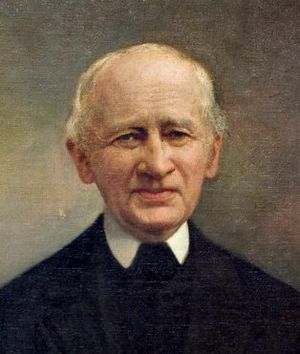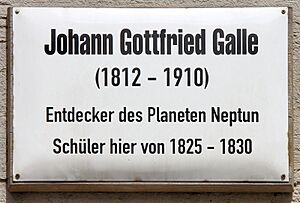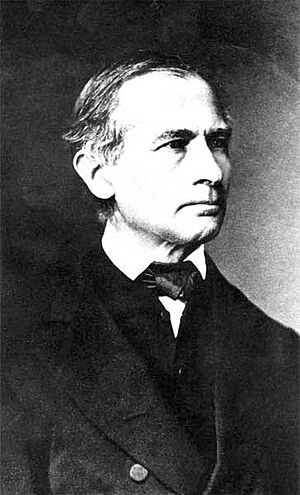Johann Gottfried Galle facts for kids
Quick facts for kids
Johann Gottfried Galle
|
|
|---|---|
 |
|
| Born | 9 June 1812 Radis, Kingdom of Prussia
|
| Died | 10 July 1910 (aged 98) |
| Alma mater | University of Berlin |
| Known for | Discovery of Neptune |
| Awards | Lalande Prize (1839) |
| Scientific career | |
| Fields | Astronomy |
| Institutions | Berlin Observatory University of Breslau |
| Signature | |

Johann Gottfried Galle (born June 9, 1812 – died July 10, 1910) was a German astronomer. He is famous for being the first person to actually see the planet Neptune. This happened on September 23, 1846, while he was working at the Berlin Observatory.
A French astronomer named Urbain Le Verrier had predicted that a new planet existed. He even calculated where it should be in the sky. Le Verrier sent these coordinates to Galle, asking him to look for it. Galle found Neptune on the very same night he got Le Verrier's letter! It was almost exactly where Le Verrier said it would be. Finding Neptune was a huge success for celestial mechanics, which is the study of how planets move. It was one of the most amazing scientific discoveries of the 1800s.
Contents
Early Life and Education
Johann Gottfried Galle was born in a small house near Radis, Germany. He was the first child of Marie Henriette and Johann Gottfried Galle, who worked with tar.
He went to school in Wittenberg. Later, he studied at the University of Berlin from 1830 to 1833. After finishing his studies, he became a teacher. He taught math and physics in Guben and then in Berlin.
Working at Berlin Observatory
In 1835, Galle started working as an assistant at the new Berlin Observatory. He worked there for 16 years. He often used a special telescope called a Fraunhofer-refractor. This telescope had a large lens, about 22.5 centimeters (9 inches) wide.
In 1838, he made an interesting discovery. He found a dark, inner ring around the planet Saturn. Between 1839 and 1840, he also discovered three new comets.
In 1845, Galle earned his PhD. His special paper was about observations made by an old astronomer named Ole Rømer.
Finding Neptune
Around 1845, Galle sent a copy of his PhD paper to Urbain Le Verrier. Le Verrier was studying the planet Uranus. He noticed that Uranus's orbit (its path around the Sun) wasn't quite right. This made him think there must be another, unknown planet pulling on Uranus.
Le Verrier calculated where this new planet should be. He sent a letter to Galle on September 18, 1846. Galle received it on the morning of September 23. That very night, Galle and his assistant, Heinrich Louis d'Arrest, started searching.
They found a "star" that wasn't on their star maps. It was only about one degree away from where Le Verrier predicted. Over the next two nights, they watched it closely. They saw that it moved, proving it was a planet! Le Verrier suggested the name Neptune for this new planet. Galle always gave Le Verrier credit for the discovery. He felt that Le Verrier's calculations were the real discovery.
Director in Breslau
In 1851, Galle moved to Breslau (which is now Wrocław, Poland). He became the director of the observatory there. In 1856, he also became a professor of astronomy at the University of Breslau. He stayed in Breslau for more than 45 years.
While in Breslau, he focused on figuring out the exact paths of planets. He also created ways to calculate the height of auroras (the northern and southern lights) and the paths of meteors (shooting stars). With his son's help, he put together information on all 414 comets discovered up to 1894. He also studied the Earth's magnetic field and climatology (the study of climate). In total, he published over 200 scientific papers.
Later Life and Honors
In 1897, Galle moved back to Potsdam. He passed away in 1910 at the age of 98. He had a wife and two sons, Andreas and Georg.
The town of Gräfenhainichen, near where he was born, put up a memorial for him in 1977.
Many things in space have been named in his honor:
- Two craters: one on the Moon and the "happy face" one on Mars.
- The asteroid 2097 Galle.
- One of the rings of Neptune.
In Breslau (Wrocław), a street was named Gallestrasse after him. This name was used until the end of World War II. Today, it is called Wapienna Street.
Legacy
Google celebrated Galle's 200th birthday with a special Google Doodle on their homepage.
Images for kids
See also
 In Spanish: Johann Gottfried Galle para niños
In Spanish: Johann Gottfried Galle para niños


